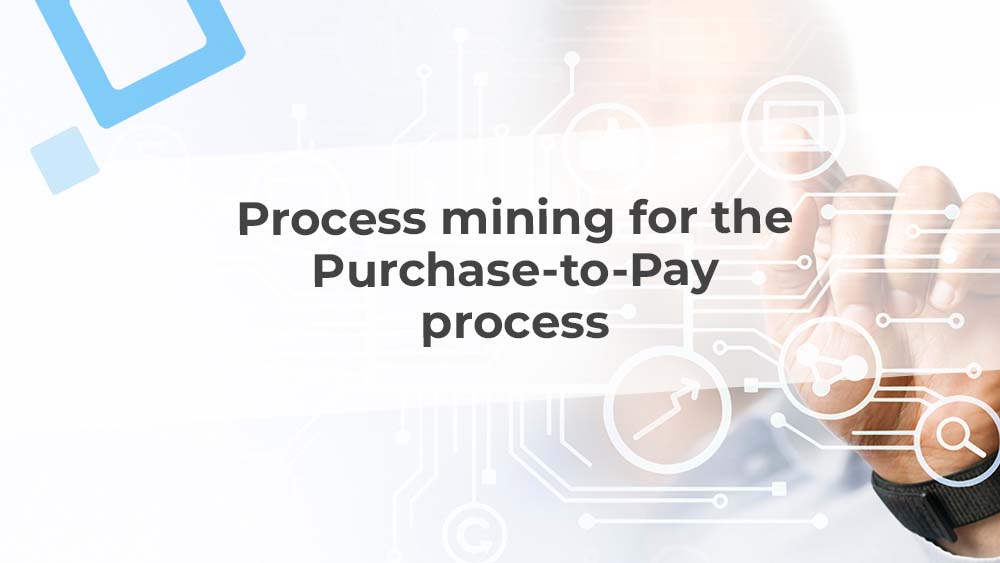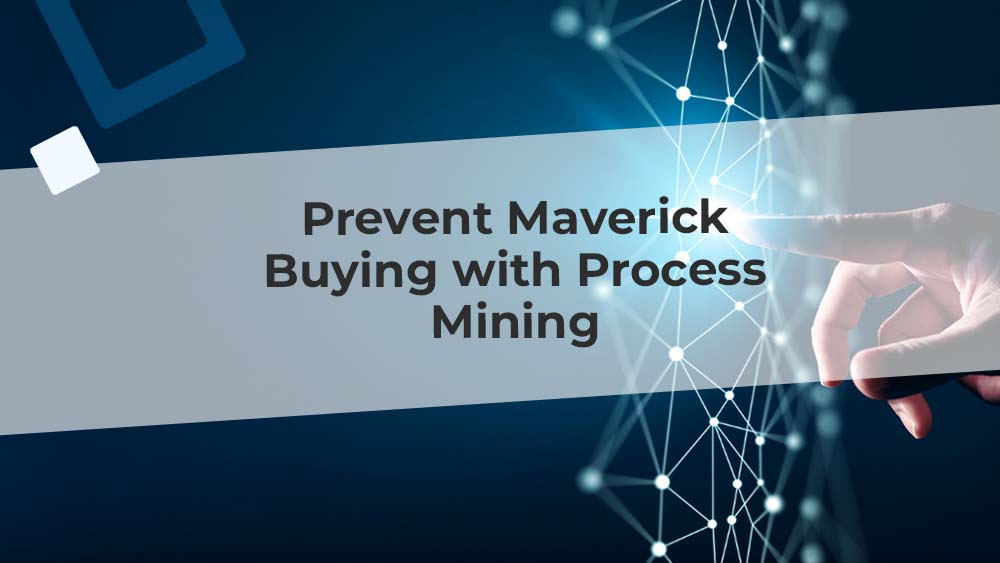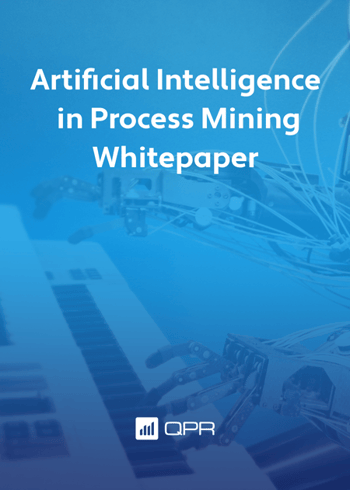What is process mining using artificial intelligence?
Only a few years ago, pen and paper were enough to map processes and try to find areas for improvement. Once a report was done, the process might have changed completely and the report was left obsolete.
Instead of using pen and paper, process mining technology (read: what is process mining) uses Artificial Intelligence and Machine Learning to automatically extract, visualize, and make sense of operational data from organizations' IT systems.
Process mining software like QPR ProcessAnalyzer helps you understand this dynamic visualization (or "digital twin") of your organization and make interesting findings: where costs can be saved, processes can be simplified, automation needs to be improved most, etc.
Not only can you find root causes for your problems, but also predict problems and get automatic alerts when problems are about to arise - so you can proactively take action.
This blog opens up how Artificial Intelligence and Machine Learning are used in process mining: cluster cases, predict problems, and more.
What is Artificial Intelligence-driven Intelligent Process Mining?
When your employees or software robots interact with IT systems – such as SAP, Salesforce, or Oracle - in your company, the activities leave a trace of data behind, referred to as an event log.
Process mining takes the data that exists in these information systems (using pre-built connectors) and uses it to visualize the real-life execution of your company’s processes together with other insights drawn from the event logs.
It points out what you should focus on in order to improve your efficiency, for instance:
- AI-driven process mining showed a large European bank that they should stop focusing on finding new opportunities for automation. Instead, they should improve the automation rate of specific existing initiatives. In two months, they increased their zero-touch rate from 5 % to 40 % which led to € 2.6 million in cost savings.
- Large companies working with internal audit and risk management use process mining to increase the efficiency and transparency of their complex, often geographically outspread operations. Intelligent process mining allows them to analyze processes and problems within the process within 2-3 hours, compared to three weeks in the past. "We now embed process mining in real-time, identify bottlenecks instantly, and take actions much earlier", said Stewart Wallace, Risk Analytics Manager at EY UK.
Process Mining and Machine Learning (ML): the Technical Explanation
Intelligent Process Mining uses machine learning algorithms to add artificial intelligence into traditional process mining. Intelligent Process Mining capabilities can be divided into four categories:- Descriptive Process Mining – Gain a deep understanding of what happened in the past.
- Diagnostic Process Mining - Understand why something happened in the past.
- Predictive Process Mining - See predictions for what is most likely to happen in the future.
- Prescriptive Process Mining - Get recommended actions to prevent future problems.
1. Descriptive Process Mining
Process mining was first developed as a descriptive method to discover patterns and gain a deep understanding of real-life business operations. While both traditional BI and process mining help you monitor KPIs and targets, process mining adds to this by helping you quickly perform pre-built process analyses in real-time. These pre-built analyses easily reveal a variety of areas for optimization: bottlenecks, compliance violations, and process deviations, which are visualized based on your actual operations.
“We gave the data of the system, and right away, in 5 minutes, we saw the bottlenecks of the process." -Piraeus Bank
The following three analyses turn the traditional process discovery to intelligent process discovery:
- Process Mining Clustering – ML naturally groups similar cases into the same clusters
- Process Mining Anomaly Detection - ML detects outliers
- Process Mining Similarity - ML finds similar cases based on an example
2. Diagnostic Process Mining
After detecting a process problem, you want to know why it happened. Diagnostic process mining provides answers not only to “what is happening?”, and “when is it happening?” – but also “why is this happening?”.
Process mining reveals problem areas in your processes by highlighting them in flowcharts and ranking them based on how they contribute to your business outcomes. This tells you what to prioritize when you want to improve your business operations.
The following functionalities show you why your problems occurred:
- Root Cause analysis – Find the root causes for any identified process problems
- Problem classification - Use machine learning algorithms to classify problems
- Trend analysis - Understand how the process has changed over time
Read a more detailed description about these categories of Intelligent Process mining in the blog: Intelligent Process Mining using Machine Learning.
3. Predictive Process Mining
In this third step, intelligent process mining predicts future problems.
Predictive process mining predicts what will happen next in any given ongoing case. By using the information from all past and ongoing cases, the machine learning system can predict the outcome of each case. The more data there is, the better the accuracy of the prediction will be.
Different predictive process mining scenarios include:
- Predict KPI outcome - ML predicts the outcome of any KPI for all ongoing cases
- Predict the next event - ML predicts the next event for all ongoing cases
- Predict final outcome - ML predicts all future events and KPIs for all ongoing cases
4. Prescriptive Process Mining
The last step, prescriptive process mining with QPR ProcessAnalyzer, introduces an ML-based Intelligent Orchestrator to help you succeed in your operations. This Orchestrator will learn and become an even better companion for you over time.
Jobs for the Intelligent Orchestrator include:- Sending email notifications
- For instance, notify people about situations where an existing business rule is about to be violated
- Activating RPA bots
- Activating new business workflows
- Updating data in ERP systems
Artificial Intelligence and Machine Learning features in QPR ProcessAnalyzer
In the past years, QPR has invested heavily in building more AI-powered features in process mining and succeeded in making QPR ProcessAnalyzer one of the leading solutions in the process mining market.
QPR ProcessAnalyzer’s Predict & Act functionality takes the standard KPI monitoring concept much further with AI/ML-based prediction capability. It allows you to act already before potential issues or bottlenecks arise. This is effectively changing the way organizations think - from late fixes to preventive actions.
With the new Predict & Act functionality, process mining can:
- Trigger an RPA bot to fix your faulty master data on the ERP system
- Let you know when deliveries are predicted to be late or SLAs are about to be broken
- Start a workflow for the escalation team to fix the vital information before any major business challenges take place.
Read a more detailed description about these categories of Intelligent Process mining in the blog: Intelligent Process Mining using Machine Learning.
Case Aalto University: Using Artificial Intelligence to drive Process Mining and Business Optimization
Since 2012, QPR has been working closely with Aalto University to develop Artificial Intelligence solutions for today's process mining use cases.
During the QPR Conference 2019, Teemu Lehto (DSc in Technology, VP Process Mining at QPR) had a joint presentation with Alexander Jung (Assistant Professor) from Aalto University, a leading institution in technology and science with a sharp focus on machine learning. The presentation discussed the use of AI to drive process mining and business optimization.
During the presentation, Teemu and Alex discussed the following challenges:
- How to use AI to drive business optimization?
- What role does clustering play in process mining?
- What can AI predict and how?
Check out the findings in the 3-page whitepaper and videos below!
Interview highlights - Alex Jung from Aalto University (55 seconds)
Whitepaper - Using Artificial Intelligence in Process Mining (3 pages)
Interview - Alexander Jung from Aalto University (5 minutes)
Presentation - Using Artificial Intelligence in Process Mining (45 minutes)
To learn more about how process mining can be applied in your organization, feel welcome to send us a message or book a demo with one of our experts.
You may also like
These related stories

Optimizing the purchase-to-pay process with process mining

Process mining for digital transformation


